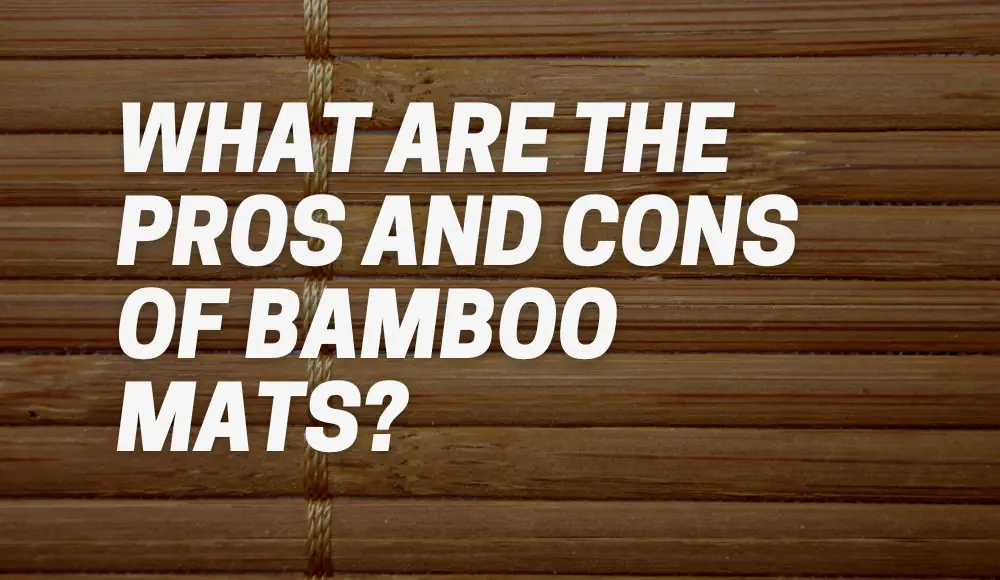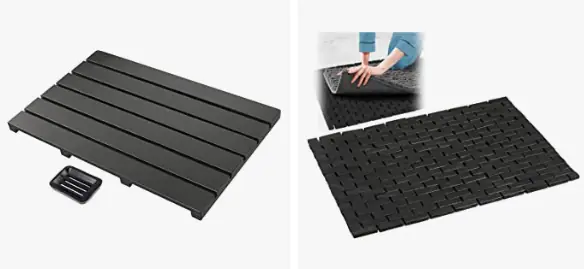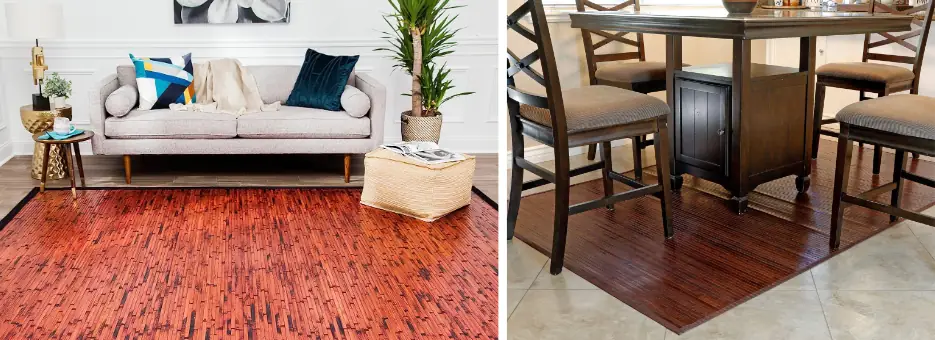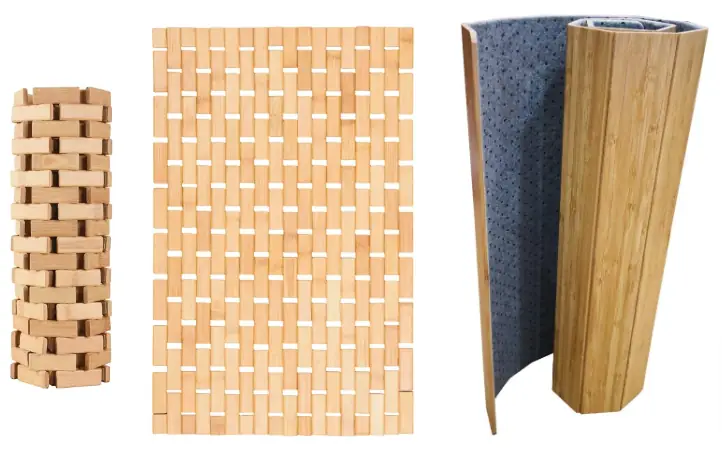If you’re looking for a versatile and eco-friendly flooring option, bamboo mats might be just what you need. Bamboo mats have gained popularity in recent years due to their unique properties and natural aesthetic appeal. In this article, we’ll explore what are the pros and cons of bamboo mats to help you make an informed decision about incorporating them into your home décor.
So, let’s dive in and explore the world of bamboo mats!
Are Bamboo Mats Good?
Bamboo mats are indeed a fantastic choice for many reasons.
First and foremost, bamboo is an incredibly sustainable material. Unlike traditional hardwoods that take decades to mature, bamboo can reach full maturity in just a few years.
This rapid growth makes bamboo a highly renewable resource.
In addition to being environmentally friendly, bamboo mats also offer excellent durability. Bamboo is known for its strength and resilience, making it suitable for high-traffic areas.
Whether you’re using it in the living room, bedroom, or even the bathroom, bamboo mats can withstand the daily wear and tear of foot traffic.
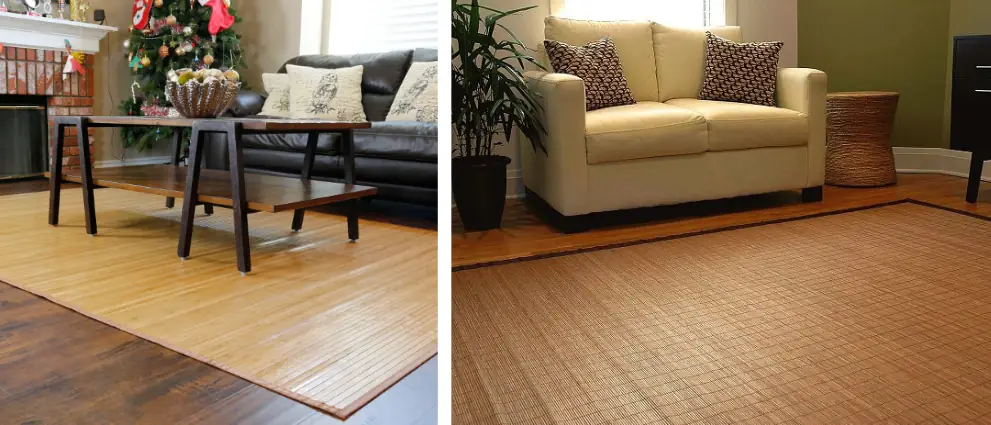
What Are the Advantages of Bamboo Mats?
Bamboo bath mat benefits:
- Eco-Friendly: As mentioned earlier, bamboo is a highly sustainable material. It requires minimal water, pesticides, and fertilizers to grow, making it an environmentally friendly choice for conscious consumers.
- Versatility: Bamboo mats come in various sizes, shapes, and designs, allowing you to find the perfect match for your home décor. Whether you prefer a natural look or a more contemporary design, there’s a bamboo mat to suit your style.
- Durability: Bamboo is known for its durability and resistance to scratches and dents. This makes bamboo mats an excellent choice for high-traffic areas, such as hallways or entryways.
- Moisture Resistance: Bamboo has a natural resistance to moisture, making it suitable for areas prone to spills or high humidity. However, it’s important to note that while bamboo mats can handle occasional spills, they are not entirely waterproof.
Can Bamboo Rugs Get Wet?
Bamboo mats have a certain level of moisture resistance, but they are not completely waterproof.
If a bamboo mat gets wet, it’s important to allow it to dry thoroughly to prevent any damage.
Wipe up any spills or moisture promptly and ensure proper ventilation in the room. Placing the mat in direct sunlight can help speed up the drying process.
Do Bamboo Mats Dry?
Yes, bamboo mats do dry.
To dry a bamboo mat, start by wiping up any spills or moisture promptly with a clean, dry cloth. Then, ensure proper ventilation in the room where the mat is placed. This allows air to circulate around the mat and aids in the drying process.
If the mat is relatively small and portable, you can also consider placing it outdoors in a shaded area or under direct sunlight, depending on the weather conditions. Direct sunlight can help speed up the drying process by evaporating any remaining moisture.
It’s essential to note that bamboo mats should not be subjected to excessive moisture or constantly damp conditions, as this can lead to warping, mold growth, or other forms of damage.
Regularly cleaning and maintaining your bamboo mat, and allowing it to dry thoroughly after exposure to moisture, will help prolong its lifespan and keep it in good condition.
Can You Put a Bamboo Mat in the Shower?
While bamboo mats can handle occasional spills in the bathroom, they are not designed to be submerged in water for extended periods.
Placing a bamboo mat in the shower is not recommended, as constant exposure to water can lead to warping and mold growth.
Are Bamboo Bath Mats Hygienic?
In terms of hygiene, a bamboo bath mat can be a great choice.
Bamboo naturally resists bacteria and mold, making it a more hygienic option compared to traditional fabric mats.
However, it’s still essential to regularly clean and maintain your bamboo mat to prevent any potential issues.
Do Bamboo Bath Mats Get Moldy?
Bamboo bath mats have a natural resistance to mold, but if they are not properly maintained or allowed to dry thoroughly, mold can still develop. To prevent mold growth, ensure that the mat is adequately cleaned, dried, and not constantly exposed to excessive moisture.
Are Bamboo Bath Mats Safe?
As for safety, bamboo mats are generally safe to use. They are free from harmful chemicals and toxins, making them a great choice for families with children or individuals with sensitivities.
Best Bamboo Bath Mat
When it comes to choosing the best bamboo bath mat, it ultimately depends on your personal preferences and needs.
However, there are some more popular and trendy options on the market:
#1 Bamboo Bath Mat Non Slip
#2 Black Bamboo Bath Mat
#3 Extra Large Bamboo Mat
#4 Roll up bamboo bath mat
Now that we’ve explored the pros and cons of bamboo mats, let’s address some frequently asked questions about their maintenance and other alternatives.
Cons of Bamboo Mats
Limited Design Options
While bamboo mats are a great choice for those who prioritize sustainability and durability, their design options are somewhat limited compared to traditional rugs or mats. Most bamboo mats are only available in natural colors, such as beige or brown.
This can be a disadvantage for those who want more variety in terms of color or pattern. To solve this issue, some manufacturers have started offering bamboo mats with printed designs on them.
These can add a pop of color or pattern to any room while still retaining the benefits of bamboo material. Another solution is to layer a smaller bamboo mat over a larger area rug that has the desired design.
Can Be Slippery
Another disadvantage of some bamboo mats is that they can be slippery if not placed on a non-slip surface. This can be dangerous, especially for elderly individuals or children who may be more prone to falls.
To prevent slipping, it’s important to purchase a mat with an anti-slip backing or place it on top of another non-slip surface such as carpeting or an anti-skid pad.
If you have pets in your home, another option is to train them not to run across the mat by placing treats on either side and gradually moving them closer together until the pet is accustomed to walking slowly across it without slipping.
Prone to Warping
Depending on the quality of the bamboo mat you purchase, it may warp over time if exposed to moisture.
While all materials can be damaged by water exposure, lower quality bamboo mats may show signs of warping sooner than higher quality ones.
To prevent warping, avoid placing your mat in areas where there’s high humidity such as bathrooms or near windows where rain might come in during heavy storms.
Additionally, make sure to wipe up spills immediately and avoid using harsh chemicals or abrasive materials when cleaning your mat.
Overall, while bamboo mats have some limitations in terms of design options and can present some challenges such as slipping or warping, they still remain an attractive and eco-friendly option for many homeowners looking for a durable and sustainable flooring solution.
How to Choose the Right Size for Your Space
When choosing a bamboo mat, it is essential to consider the size of your space. A mat that is too small may not serve its intended purpose, while a mat that is too large can be visually overwhelming.
The first step in selecting the right size is determining what function the mat will serve.
If you intend to use it in your bathroom or kitchen, measure the area where you would like it to be placed and choose a mat that fits well in that space.
If you’re looking for a mat for your living room or bedroom, it’s important to consider how much floor space you have available and what furniture will be placed on or around the mat.
You don’t want the mat to take up too much room or feel cramped by surrounding objects.
Additionally, different shapes and sizes can create unique design effects, so consider not only what size works best but also what shapes might complement your interior design.
Tips for Maintaining Your Bamboo Mat’s Quality Over Time
Bamboo mats are relatively low maintenance but require some care over time to ensure their longevity. One of the most critical aspects of caring for your bamboo mat is regular cleaning.
Dusting or vacuuming once a week can help prevent dirt from building up and prolongs its life span. Additionally, avoid exposing your bamboo mat to excess moisture as this could cause warping over time.
If accidents happen and liquid spills on your bamboo mat immediately clean up any excess moisture with a towel and allow it to air dry completely before returning it to its position.
Avoid placing heavy furniture directly on top of your bamboo mat as this could cause denting over time.
Instead, use coasters or felt pads under legs or feet when placing furniture on top of them to ensure even wear and tear over time.
By following these simple tips, you can ensure that your bamboo mat remains in excellent condition for years to come.
FAQs
Are Bamboo Mats Easy to Clean?
Yes, bamboo mats are generally easy to clean. Regular maintenance involves sweeping or vacuuming to remove dust and debris.
For spills or stains, you can use a damp cloth or sponge with mild soap and water to gently clean the affected area. Avoid using abrasive cleaners or excessive moisture, as it may damage the mat.
Which Mat is Best for the Bathroom?
Apart from bamboo mats, there are other materials suitable for bathroom mats. Some popular alternatives include:
- Cotton: Cotton mats are soft, absorbent, and easy to clean. They are a great choice for those seeking a cozy and comfortable feel in the bathroom.
- Microfiber: Microfiber mats are highly absorbent and quick-drying. They offer excellent water absorption properties, making them ideal for wet areas like the bathroom.
- Rubber: Rubber mats provide excellent slip resistance and are perfect for preventing accidents in the bathroom. They are easy to clean and maintain as well.
Ultimately, the best mat for your bathroom will depend on your specific needs, style preferences, and the level of moisture resistance required.
Conclusion
Bamboo mats offer numerous advantages, including sustainability, durability, and moisture resistance. While they are not suitable for constant water exposure, they can be a great addition to various areas of your home.
By understanding the pros and cons of bamboo mats, you can make an informed decision that aligns with your lifestyle and aesthetic preferences.
Whether you choose a bamboo mat for its eco-friendliness or its unique charm, it’s sure to add a touch of natural beauty to your living spaces.
